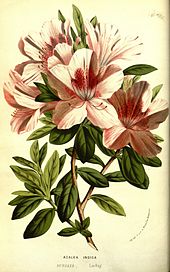Ludwig Leopold Liebig
Ludwig Leopold Liebig (born January 16, 1801 in Schwedt / Oder ; † January 20, 1872 in Dresden ) was a German gardener and plant breeder who was best known for the first German azaleas breeding . Alongside Jacob Friedrich Seidel, Liebig was considered the “second nestor of Dresden horticulture”.
Life
Liebig was born the son of a city official. He completed his apprenticeship in the palace gardens of Schwedt Palace . Through his military service he came to Berlin, where he worked as a gardener's assistant on Pfaueninsel after his service . There he met the court gardener Gustav Adolph Fintelmann , with whom he undertook several training trips, including to Paris, Munich and Düsseldorf. In Düsseldorf Liebig met the gardening inspector Weihe, who suggested him as head gardener for the Wäber nursery in Dresden; Liebig accepted the same post in 1832.
Ludwig Leopold Liebig was married to Hildegard Richter, a sister of the draftsman and painter Ludwig Richter . He died of a stroke .
Horticultural work
After Liebig started working for the Wäber nursery in 1832, he first traveled to Belgium , England and Scotland , where he acquired rare plants in Germany at that time, such as various types of rhododendron , and transferred them to the nursery in Dresden. In the following years Liebig managed to lead the company to economic success. After Wäber's death in 1837, Liebig acquired the nursery and property on today's Hopfgartenstrasse in Dresden's Johannstadt from his heirs. In addition to the Seidel nursery, the Liebig nursery was one of the first German commercial and commercial nurseries to specialize in the breeding and sale of camellias , azaleas and other rhododendrons. His customers included members of the Rohan family and the Austrian naturalist Carl Alexander Freiherr von Hügel .
In 1843 Liebig was the first gardener in Germany to breed his own azalea, the Aurora ; other varieties followed. Until Hermann Seidel's Dresden nursery presented its own azalea variety in 1867, Liebigische Gärtnerei was the only German breeding site for new azaleas. Liebig bred numerous other rhododendrons, camellias and begonias . His range also included up to 300 different types of Erikas . His plants were traded and exhibited nationally and internationally. Liebig also planted the first magnolia in Dresden.
After Liebig's death, his son Emil (1839–1887) took over his father's gardening business and continued his cultivation and trading business. Records from 1887 show that there were 300,000 azalea plants in the Liebig nursery. After Emil's death, the company was relocated to Niederwaldstrasse in Striesen , which was then one of the most important horticultural locations in the German-speaking region. The nursery business continued until 1898.
The botanical collections at Schloss Beimendorf in Pirna contain several azaleas cultivated by Liebig.
literature
- State Office for Environment, Agriculture and Geology , State Association of Horticulture Saxony, Association of former Dresden-Pillnitzer (Ed.): 200 years of ornamental plant cultivation in Saxony . Laske-Druck, Pirna 2013.
Remarks
- ↑ In some sources Liebig's first names are reversed.
- ↑ The name Wäber is in historical sources in the spelling Waeber handed.
Individual evidence
- ^ Gerhard Schimmler: The development of the camellia, azalea and heather cultures in Germany with special consideration of the Saxon growing area . Triltsch, 1934, p. 102 .
- ^ A b c Karl Koch (Red.): Ludwig Leopold Liebig. A biographical sketch . In: Weekly of the Association for the Promotion of Horticulture in the Königl. Prussian states for horticulture and botany . No. 6 . Wiegandt & Hempel, Berlin February 10, 1872, p. 41 f . ( limited preview in Google Book search).
- ^ A b Lars Herrmann: Hopfgartenstrasse. In: www.dresdner-stadtteile.de. Retrieved February 16, 2017 .
- ↑ a b c d Botanical Collections Schloss Beimendorf - Our collection “Indian Azaleas”. (No longer available online.) Archived from the original on February 20, 2017 ; accessed on February 17, 2017 . Info: The archive link was inserted automatically and has not yet been checked. Please check the original and archive link according to the instructions and then remove this notice.
- ↑ Helmut Vogel: Azaleas, Eriken, Camellias . Paul Parey, Berlin and Hamburg 1965, p. 45 .
- ^ Karl Koch (Red.): Horticultural excursion of a botanist . In: Weekly of the Association for the Promotion of Horticulture in the Königl. Prussian states for horticulture and botany . No. 40 . Wiegandt & Hempel, Berlin October 4, 1860, p. 314 f . ( limited preview in Google Book search).
| personal data | |
|---|---|
| SURNAME | Liebig, Ludwig Leopold |
| BRIEF DESCRIPTION | German gardener and plant breeder |
| DATE OF BIRTH | January 16, 1801 |
| PLACE OF BIRTH | Schwedt / Oder , Germany |
| DATE OF DEATH | January 20, 1872 |
| Place of death | Dresden , Germany |

